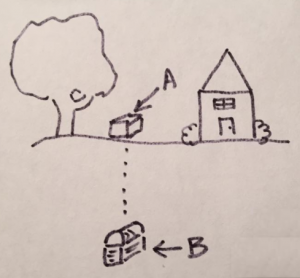2.2.1: Discover What a Text is Trying to Say
- Page ID
- 25724
All texts—whether fiction or nonfiction—carry layers of information, built one on top of the other. As we read, we peel those back—like layers in an onion—and uncover deeper meanings.

Figure 1 - Hidden Meaning
Take a look at Figure 1 above. I use this in the classroom to explain the “deeper meaning” concept to students. All texts and stories have surface meaning. In the sketch, this is represented by all the things we see above ground: the tree, the house, and the box (A), along with whatever is in it—even though the box may be closed, anyone who walks by can see it and explore it. These items are concrete and obvious. In “Goldilocks and the Three Bears,” for example, the surface story is about a little girl who goes for a walk in the forest, wanders into the bears’ home, gets into their belongings, and is frightened off.
But stories and essays also have deeper, hidden meanings. In Figure 1, there’s a buried treasure chest (B) deep underground, waiting to be discovered and opened. Texts are much the same—they each contain obvious, surface level meanings, and they each contain a buried prize as well. What’s the deeper meaning in “Goldilocks”? Most fables and fairy tales were designed to teach, warn, or scare. Perhaps the author wants us to think about what happens when we invade people’s privacy. Or maybe it’s about the drawbacks of curiosity. What do you think?
When working with a text, be aware of everything that is happening within it—almost as if you’re watching a juggler with several balls in the air at one time:
- Consider the characters or people featured in the text, their dialog, and how they interact.
- Be aware of the plot’s movement (in a fictional story) or the topic development (in a nonfiction story or essay) and the moments of excitement or conflict as the action rises and falls.
- Look for changes in time—flashbacks, flash-forwards, and dream sequences.
- Watch for themes (ideas that occur, reappear, and carry meaning or a message throughout the piece) or symbols (objects or ideas that stand for or mean something else; these carry meaning that we often understand quickly without thinking about it too much).
Examples of themes: coming of age, redemption, the nature of honesty, conflict, sacrifice.
Examples of symbols: full moon (typically suggests mystery), dark forest (danger or the possibility of being lost), white flag (surrender), a path or road (journey).
As you read, always look for both surface meanings and those buried beneath the surface, like treasure. That’s the fun part of reading—finding those precious hidden bits, waiting to be uncovered and eager to make your reading experience richer and deeper. Even if you just scratch the surface, you’ll learn more.
License and Attributions:
CC licensed content, Previously shared:
The Word on College Reading and Writing. Authored by: Carol Burnell, Jaime Wood, Monique Babin, Susan Pesznecker, and Nicole Rosevear. Located at: https://human.libretexts.org/Bookshelves/Composition/Book%3A_The_Word_on_College_Reading_and_Writing_(Babin_et_al.)/Part_1/2%3A_Building_Strong_Reading_Skills/2.07%3A_Discover_What_a_Text_is_Trying_to_Say
License: CC BY: Attribution.
Adaptions: Reformatted, some content removed to fit a broader audience.

